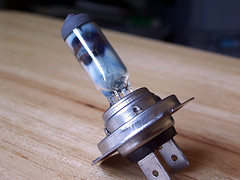 On Wednesday night I noticed that one of my headlights wasn’t working. Curiously, it was the bulb that I had changed only about six months ago that had given up the ghost.
On Wednesday night I noticed that one of my headlights wasn’t working. Curiously, it was the bulb that I had changed only about six months ago that had given up the ghost.
So I went to Halfords yesterday and bought myself a replacement bulb (and a spare, but that is by the by). But my dreams of a swift and easy changeover were hampered somewhat by the fact that the bonnet wouldn’t open. As you can imagine, at this point I became a little stressed out. I had visions of myself having to submit the car to be crushed into a tiny cube, simply because the engine compartment was now an impenetrable fortress and there was no engine oil or windscreen washer fluid left.
Google is your friend – I found [this][]:
[this]: http://groups.google.co.uk/group/uk.rec.cars.maintenance/browse_thread/thread/20c1f70f4831c4b8/
> Pull the lever and have your mate press down on the bonnet where the catch is. Worked on my Cav ((Vauxhall Cavalier)). I think the cable has stretched a bit. I made a temporary repair by putting a Scotchlock connector on the end of the release cable. (Temporary = 3 years ago and it still works well!)
Sure enough, it worked. Valuable tip there.
Which leaves me only with the question – why did the bulb only last for a few months?
7 replies on “Bulbs. Not the garden sort.”
I would also suggest not doing what I did, which is to say, put the bulb in upside down, so that it’s point skywards.
There is a reason I shouldn’t be allowed to do manual labour type things. I break stuff.
Not sure that I quite follow you. If you’re talking about garden bulbs, then they are supposed to be point skywards. If you are not, then I’m completely flummoxed.
You can fix the cable by squirting a bit of WD-40 or another kind of spray lubricant into the end near the bonnet catch – it will lubricate the inside of the cable a bit and usually eases the stretch enough for the cable to go back to normal.
Your globe will last longer if you are careful not to touch the glass bit with your fingers. (And if you do, clean it with methylated spirits.) When you touch the bulb, you leave tiny traces of finger grease on the glass, which heats up when the bulb illuminates, ultimately creating a weak spot where the bulb finally fails.
So when you put the bulb in, hold the glass bit with a clean, dry rag or tissue.
Sometimes you get a dodgy bulb. That’s all there is to it, I’d say (speaking as someone who has an inordinate amount of experience with halogen bulbs, and who’s monthly bulb budget where he works exceeds £500).
**Damian:** Yes, I’m aware of the need to avoid skin contact. To be honest, that’s part of the reason why I posted the photo of the bulb: sometimes the appearance of the dead bulb can contain clues about its demise. I’m a little concerned that I may have brushed the bulb with the heel of my hand while I was trying to manoeuvre the assembly back into place.
**Matt:** I think I’m going to run with this assumption for now. If this bulb doesn’t last long, then I think that I’ll investigate the possibility that the problem lies elsewhere in the circuit.
Matt: That’s what I told him. But it needed for a bloke to say it for it to be true.
In my experience, about 1 in every 4 bulbs would be considered ‘dodgy’, especially with halogen bulbs, or any bulb above 300w. Energy-saving household bulbs are exempt from this statistic. If you touch a halogen lamp, it needs to be cleaned with a very dry cloth or lens tissue before it is powered.
In work (a theatre) I use bulbs that are up to 2500w in power, and you find when you get to that level, the manufacturers are a little bit more stringent in their QA, so there’s very rarely a dodgy one.